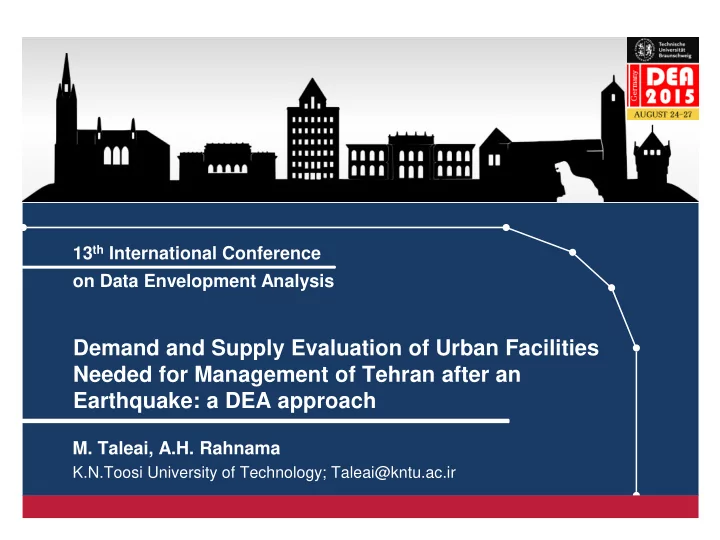

13 th International Conference on Data Envelopment Analysis Demand and Supply Evaluation of Urban Facilities Needed for Management of Tehran after an Earthquake: a DEA approach M. Taleai, A.H. Rahnama K.N.Toosi University of Technology; Taleai@kntu.ac.ir
Introduction • Spatial distribution and accessibility of victims to urban facilitates such as health centers, highways and streets is one of the important issues for management of the crisis caused by an earthquake. • DEA (as a multi-criteria analysis method) and spatial analysis can be utilized to evaluate the balanced distribution of urban facilities. • DEA can use to model the balance of supply and demand, lack of supply or excess demand in every region of the Tehran (as DMUs). 13 th International Conference on Data Envelopment Analysis 2015 | Page 2
Materials and Methods • Output-oriented CCR model is used. • The 22 regions of Tehran were selected as the decision-making units (DMUs). • The DEA-Solver software was used to determine the overall performance of DMUs. 13 th International Conference on Data Envelopment Analysis 2015 | Page 3
Materials and Methods: Research Steps Determining social vulnerability criteria for Tehran Determining inputs and outputs in DEA Model Collecting spatial and descriptive data for each criterion Data Envelopment Analysis using CCR Model Rating regions of Tehran according to social vulnerability Visualizing the results and preparing a map to represent social vulnerability to earthquake 13 th International Conference on Data Envelopment Analysis 2015 | Page 4
Materials and Methods: Evaluation criteria Average population density in different regions Number of buildings/houses Population Number of families Indicators Population in the below 5 years vulnerable age Social Vulnerability above 88 years group Number of unemployed population Socio- economic Indicators Number of uneducated people 13 th International Conference on Data Envelopment Analysis 2015 | Page 5
Case Study: Tehran, Iran • The Great Tehran, capital of Iran, located in the foothills of the Alborz Mountains, a part of the Alps-Himalayan orogenic belt. • It has a high seismic potential and numerous active faults. • According to the data achieved from the past earthquakes, Tehran has suffered from many powerful earthquakes with return period of 150 years. • Since 1830, Tehran has experienced no major earthquake • Seismologists anticipate the occurrence of a great earthquake in Tehran in the future (JICA, 2000). 13 th International Conference on Data Envelopment Analysis 2015 | Page 6
Case Study: Tehran, Iran Seismic hazard zoning map of Iran (Moinfar et al, 2012, WCEE) 13 th International Conference on Data Envelopment Analysis 2015 | Page 7
Fault map of Tehran region 13 th International Conference on Data Envelopment Analysis 2015 | Page 8
Results: Factor maps as the input of DEA model 13 th International Conference on Data Envelopment Analysis 2015 | Page 9
Results: Social vulnerability map of Tehran regions 9, 13 and 22 have good balance between supply and demand of the facilities. 13 th International Conference on Data Envelopment Analysis 2015 | Page 10
Discussion Table 1: Efficiency of each municipality region (DMU) for management of the Tehran after an earthquake Overall Rank based on Overall Rank based on DMU # Efficiency social vulnerability DMU # Efficiency social vulnerability score (Ascending) score (Ascending) 22 1 1 20 0.46 12 9 1 2 6 0.45 13 13 1 3 3 0.42 14 12 0.96 4 18 0.42 15 17 0.89 5 8 0.40 16 16 0.82 6 14 0.33 17 19 0.61 7 5 0.32 18 10 0.57 8 2 0.31 19 11 0.53 9 7 0.30 20 21 0.51 10 15 0.27 21 1 0.50 11 4 0.21 22 13 th International Conference on Data Envelopment Analysis 2015 | Page 11
Conclusion • DEA as a multi-criteria evaluation method to determine vulnerability to earthquake • DEA, contrary to other methods like AHP, lets to obtain the weights of criteria by the method itself, and to avoid the inclusion of subjective preferences. • Integration of the DEA with GIS enabled us to add spatial criteria to the DEA method. • Further studies are suggested to focus more accurately on factors influencing social vulnerability to earthquake and pay more attention to sustainable and cultural-religious development in further studies. 13 th International Conference on Data Envelopment Analysis 2015 | Page 12
Recommend
More recommend